
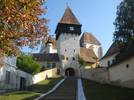
It is a 15th century church with Roman parts built in the 13th century and a surrounding wall from 15th and 16th century. The church is placed in the North-Eastern part of the village. The body of the church has the shape of a tower. Some Roman details (the Western gate, the alcove in the loft) show the existence of a building before the 13th century. By the end of the 19th century the tower of the loft and the tower of the gate had an open sentinel passage. On the Northern wall of the loft there is a sacramental rock alcove dated 1504. One would also notice: the baroque harmonium and a stall from the 16th century. In the bell tower and in the tower gate there are three bells from before the Reform.
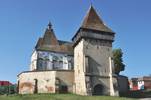
While in the Occident the Popes at Avignon were being captured and in the Orient the Copts were being persecuted by the Mamluk sultan, the deed Teodorich de villa Boneti mentioned for the first time the name of Boian as the home of the Archbishop of Tarnava Mica, in 1309. The place became of high importance to the lords from the Eastern part of the Carpathian Mountains when around 1488 King Matei Corvin gave away several villages as feuds to be mastered to the times of Alexandru Lâpușneanul. The appurtenance to the district of Cetatea de Balta and the domination thereof left marks on the fortified church on the Northern wing of the aisle, close to the eaves of the roof, but specially on the bell tower where on a circular plate one can see the representation of the bison with stars between the horns. These stand as the only undisputable proofs of Moldavian heraldic marks in Transylvania.
The church shaped as a hall of stones is made of an aisle and a rectangular altar. The first fortified element of the Evangelical church, from the beginning of the 16th century, was the star-shaped vault of the loft over heightened by a guard elevation on bold arcades supported by consoles. Under each arcade were hidden the spilling hatches for pitch and the wall was provided with ramparts. The polygonal walls of the apsis may have been replaced by a wall supported from outside by a hinge, by a counterfort. The date on the triumphal arch, the year 1506, suggests the completion date of the loft fortification and not the date construction begun. The tabernacle has been around from the same year. Between 1430-1440 there was an important polyptych altar here whose prominences may be related to the workshops in Slovakia. The current baroque altar goes back to the 18th century; same goes for the rood loft painted by Ștefan Valepagi of Mediaș. The parts of the paintings on the Northern wing most probably go back to the previous century as deducted from the links with the paintings in the church of Medias which is registered in the second half of the 15th century. The star-shaped vault of the aisle lasted to 1900 when it was replaced by a stucco ceiling.
When the loft was reinforced, in the first half of the 16th century, also the surrounding fortress with octagonal casing and three defense towers have been built. The six meter high walls have ramparts and are supported by counterforts. Below the massive square tower, that also had the function of a bell tower, there is the entrance surrounded by a metallic grid. (Source: www.biserici-fortificate.com)

The church shaped as a hall and built at the beginning of the 15th century is placed in the centre of the village. From the point of view of the design it belongs to Late Gothic. The vast loft closed by three edges towards the Eastern side is separated from the hall by an unusually high triumphal arch and the light enters the hall through three windows formerly closed in a broken arch.
The Southern wall of the hall still has three narrow windows shaped as broken arches
while there’s no window on the Northern wall. On the Western front there was a 2 meter high and 1.5 meter wide portal that was later on walled. The only entrance in the church, on the Southern side, forms another broken arch, clearly moulded with plaster finish.
The fortress
Originally the walls of the hall were higher than what we see today and they surrounded the yard in an approximately oval shape. The fortress is bordered on the Eastern side by the steep shores of a creek that form a natural defense barrier. For a long lasting life the wall should have been minimum 5 meter high so we draw the conclusion that the top part of the wall had ramparts that one could get to from a sentinel passage. In the middle of the Southern part of the fortress, above an arched entrance, there is the bell tower. (Source: www.biserici-fortificate.com)
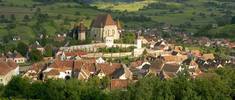
The ecclesiastic and defense complex was built in the 15th – the 16th centuries in the late Gothic style, with specific Renaissance elements.
For 300 years Biertan was chosen as the residence of the Evangelic Diocese (1572-1867)
The main edifice of the ensemble is a hall-church with three aisles, with arches disposed as a network, built between 1492 - 1516 in place of an old church, in the Late Gothic style, with elements from the Renaissance architecture at some portals.
The late Gothic altar, with a triptych shape, was gradually built between 1515 -1524.
The stalls have been made between 1514 -1523 by Reychmut from Sighisoara and are among the most valuable stalls of this kind in Transylvania.
The door of the vestry, built in 1515, Unique in its way, is remarkable for its locking system.
After the earthquake in 1977 the arches have been restored and consolidated.
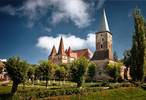
Carved out by the skilful and restless hands of the Saxon stonemasons (brought in Transylvania to help defense the borders of the Hungarian Empire sometimes in the 12th century), the fortified church of Mosna stands as evidence of the history of the places and people, outstanding companion to other Saxon dwellings along the history, a true story teller of troubled times and Saxon civilization that was such an important part of the history of Transylvania. All those that are willing to take a few hours of their vacation and come to this place, will find the village of Moșna in Mosna Valley, an affluent of the river Tarnava Mare, on County Road (DJ) 141, 10 km South of Medias.
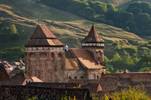
You can find in Valea Viilor one of the most impressive fortified churches in Transylvania. Church Sf. Petru, built in the 13th century, has been extended and fortified in the 15th – the 16th century and the works were roughly finished in 1520. Surrounded by a heavy line of walls and towers, the church itself looks like a huge redoubt with a tower above the loft and a tower on the West side. The aisle has an arched ceiling with a complicated network of arch ribs leaning on 7 pairs of pillars that are half hidden in the wall. The loft has the same type of ceiling. At the outset of the 16th century the church underwent some changes. Around 1520 the main entrance, on the West side, below, the bell tower, has been walled. In front of the entrance a counterfort has been erected and, at 10 meters high, has been tied with two counterforts to create a sentinel passage. Two entries have been opened in the church, one on the South side and the other one on the North side. Each gate has a defense metallic grid and a tower with round stairs. The loft suffered major changes; it was built-in into the massive wall of the four story tower. Above the first roof of the tower there is a sentinel passage and above the sentinel passage a second roof. In 1738 the church was damaged in an earthquake and the repair works were finished in 1742. Reconditioning works were also performed in 1781 and1826. The church is enclosed by a surrounding wall which still has 4 towers (ramparts). The Eastern tower lasts from 1501, and one may assign the same year for the construction of the surrounding wall that still has an arched sentinel passage, especially in the South side which holds better than the one in the North side. You can still find inside the baptistery: the priest’s stall from 1526, the altar from 1779 with sculptures carved by Johann Folbarth of Sighișoara, the ring above the rood loft from 1746, and the tabernacle on the North side of the loft from 1504. The citadel-church is made of an oval enclosure with arcades and defense hall, doubled in the North and South sides. The church is part of the list of UNESCO historical monuments.
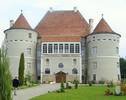
Bethlen-Haller Castle was built in the French Renaissance style of the 17th century (1615-1624); it is a quadrilater with circular corner towers, no defense role assigned. The general layout reproduces at a smaller scale the central body of the Chambord Castle in France. The Castle has been re-framed in 18th century with a Baroque gate.
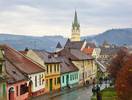
In the heart of the medieval town of Medias there is the evangelical church Sf. Margareta. In July 13, the Sf. Margareta day, there was an important fair where all the craftsmen of all parts of Transylvania would meet, where various craftsmen guilds would establish the means to protect their professional and commercial interests. After the great Turkish invasion of 1438 that brought severe damages to the town of Medias as well, the defense fortress existent at the time was reinforced around the church by a double wall and several defense towers. This complex of entrenchments has been kept to nowadays. In 1550 Medias was declared town and the church tower has been elevated by three stories. In 1551 small towers were built on each corner of the main tower as a sign of the town of Medias being entitled to pass and carry on the death sentence.

Sighișoara was for the first time recorded in 1280 under the name of CASTRUM SEX. The borough is placed on a hill with two plateaus: the superior one towards sunset, a higher and narrower plateau, and the inferior one towards sunrise, 40 meters below the level of the superior one, but significantly wider. This configuration of the land determined both the urban development of the borough as well as the defense system thereof. The first citadel – recorded in 1280 – was built on the superior plateau and served as refuge for the inhabitants of the village at the foot of the hill. In the 14th century the inferior plateau became home for a large number of artisans that, in 1376, were organized in guilds. The economic prosperity of the artisans and traders of Sighisoara is proven by the large financial resources that must have been used to create such a powerful defense system that was built in the second half of the 14th century and in the 15th century which made Sighisoara one of the hardest citadels to conquer at that time in Transylvania. The wall of fortresses is a 930 meter long and 4 meter high wall, that was initially made by stone and that expands on both plateaus of the hill. Approximately half way up there was a sentinel road for archers. (Source: www.bazna.eu)
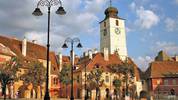
Sibiu was first recorded in 1321 under the name of Hermannsdorf; in the second half of same century Sibiu became a civitas as recorded in a document of 1366 that mentions the place for the first time under the name of Hermannstadt. Towards the end of the 15th century the so called Saxon University was incorporated; it had the role of managing the administrative affairs of all Saxons and it was led by a Royal Judicator and later on by a Saxon Committee. Later on the Saxon University also had jurisdiction over Romanian villages, namely over the so called Saxon Seats where there were no Saxon inhabitants (T. Nigler). The medieval period was characterized by a continual economic development marked by the activity of the guilds. The first bylaws of the guilds (1376) list 19 guilds with 25 professions; the 16th century shows guilds (like the cobblers) with members that worked in the Principality of Wallachia or in Moldavia. The number of guilds increased gradually so that in the second half of the 16th century there were 29 guilds, and close to 1780 there were 40 certified guilds in a time when the craftsmanship role was already highly important. The disaster of the Hungarian Empire that occurred at Mohacs in 1526, the occupation of the capital Buda (1541) and the formation of the Principality of Transylvania have forced the Saxon community, and implicitly the Sibiu community, to play a double game by practicing in turn their natural Habsburg politics if we take into account the ethnic and cultural characteristics, and pro-ottoman politics. That caused Sibiu to fall under siege several times by both parties; nevertheless Sibiu kept its privileges. At the same time, starting with 1543, the Saxons adopted the religious reform and switched "in corpore" to Lutheranism, a religious view that most of them still share. In 1550 the Large Square (”Piața Mare”) became the host of the "tower of infamy", a Gothic monument with the statue of Roland on top, carved by the sculptor Onoforius.